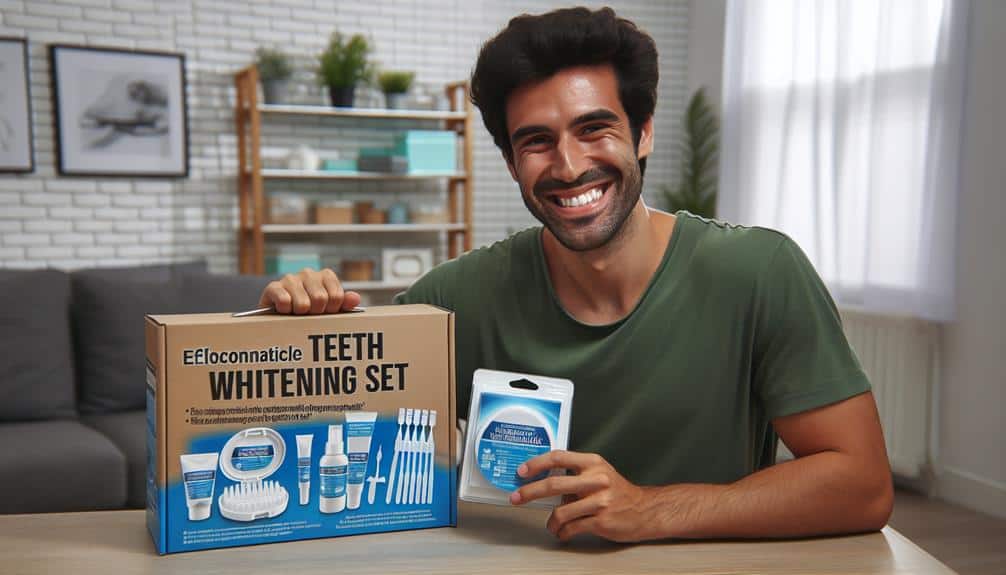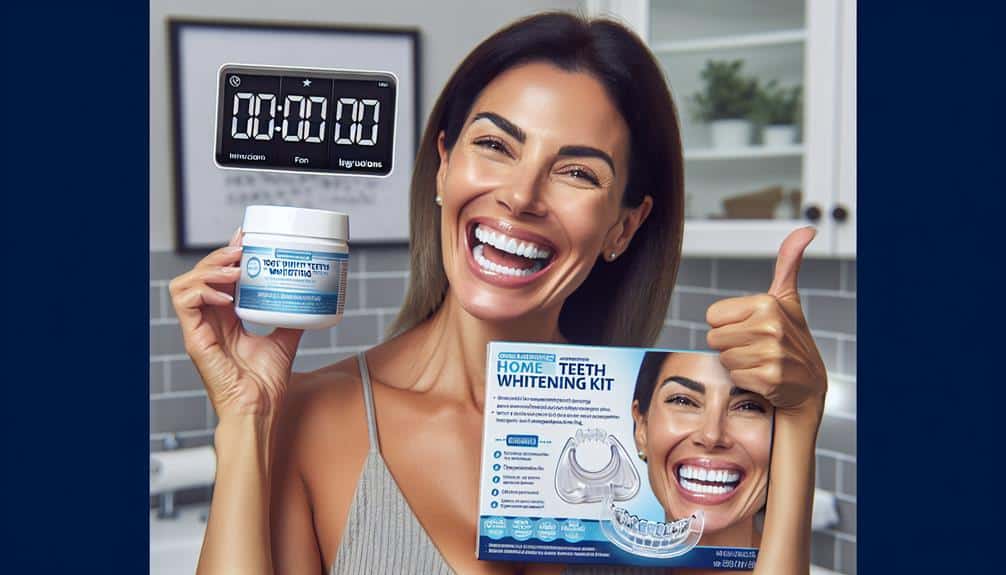Begin your teeth brightening journey at home by selecting the right whitening kit that suits your needs and is positively reviewed. Prioritize safe ingredients like hydrogen peroxide for effective results. Master application techniques by ensuring teeth are clean before applying the gel and follow the recommended duration. Maintain bright teeth by establishing a consistent oral care routine that includes regular brushing and flossing, limiting staining foods, and incorporating crunchy fruits and vegetables into your diet. Explore more tips to enhance your at-home teeth brightening experience.
Key Points
- Choose a whitening kit tailored to your needs and preferences
- Master precise application techniques for optimal results
- Maintain oral hygiene with regular brushing, flossing, and healthy diet
- Avoid staining foods and beverages like coffee and red wine
- Incorporate natural teeth cleaning foods like crunchy fruits and vegetables
Choosing the Right Whitening Kit
When selecting a whitening kit for your teeth, it's important to consider your specific needs and preferences to achieve the best results. Product comparisons are vital in determining which kit will be most effective for you. Look for kits that have been positively reviewed, focusing on those with a proven track record of success. Consider factors such as the level of whitening you desire and the sensitivity of your teeth.
In addition to product comparisons, ingredient safety is paramount. Choose kits that use safe and approved ingredients to avoid any potential harm to your teeth or gums. Check for ingredients like hydrogen peroxide or carbamide peroxide, which are commonly used in effective and safe whitening products. Be cautious of kits that contain high levels of abrasive substances that can harm your enamel. Prioritize your oral health by selecting a kit with ingredients that will brighten your teeth without compromising their integrity.
Application Techniques for Best Results
For best results, mastering precise application techniques is vital when using a teeth whitening kit at home. When it comes to brushing methods, make sure that your teeth are clean and dry before applying the whitening gel. Use a soft-bristled toothbrush to gently brush your teeth, focusing on each tooth's surface to remove any plaque or debris that could interfere with the whitening process. After applying the gel, avoid eating or drinking for at least 30 minutes to allow it to set properly.
The time commitment required for best results is important. Follow the instructions provided with your whitening kit carefully to determine the recommended duration for each session. Overusing the whitening gel can lead to tooth sensitivity and gum irritation, so it's crucial to adhere to the specified application times. Consistency is key; establish a routine that fits your schedule to ensure you can commit to the recommended frequency of treatments for the best outcome.
Maintaining Brightness for Longevity
To maintain the brightness of your teeth for longevity, it's crucial to establish a consistent oral care routine that includes regular brushing, flossing, and the occasional touch-up whitening treatment. Brushing your teeth twice a day with a fluoride toothpaste helps eliminate surface stains and prevents plaque buildup, which can lead to discoloration. Flossing daily is equally important as it removes food particles and plaque from between your teeth, areas that a toothbrush may not reach effectively.
Diet impact plays a significant role in maintaining bright teeth. Limiting the consumption of staining foods and beverages like coffee, tea, red wine, and dark berries can help prevent new stains from forming. Additionally, incorporating crunchy fruits and vegetables like apples, carrots, and celery into your diet can naturally scrub your teeth and stimulate saliva production, which aids in keeping teeth clean.
Natural remedies such as baking soda and hydrogen peroxide can be used occasionally to supplement your oral care routine. Baking soda can gently scrub away surface stains, while hydrogen peroxide can act as a natural whitening agent. Remember to consult with your dentist before trying these remedies to make sure they're appropriate for your teeth.
Frequently Asked Questions
Are There Any Natural Remedies or DIY Methods That Can Effectively Whiten Teeth at Home?
For a brighter smile at home, consider natural remedies like baking soda or activated charcoal for effectiveness. DIY methods such as oil pulling or hydrogen peroxide can be safe options. Always consult with a dentist for guidance.
Can Teeth Whitening Products Cause Any Long-Term Damage to the Enamel or Gums?
To protect enamel, choose teeth whitening products with enamel-safe ingredients. Safeguard gum health by following instructions carefully. Long-term damage is less likely if you prioritize enamel protection and maintain gum health with proper usage.
How Often Should I Whiten My Teeth at Home to See Optimal Results?
For best results, whiten your teeth at home every 6-12 months. Consistent upkeep is essential to maintaining brightness. To prevent enamel damage, follow product instructions diligently, and consider using desensitizing toothpaste.
Are There Any Foods or Drinks I Should Avoid to Prevent Staining My Teeth After Whitening?
To prevent staining after whitening, avoid the worst drinks like coffee, tea, and red wine. Opt for the best foods like crunchy fruits and veggies that naturally clean teeth. Use non-invasive techniques to maintain your bright smile.
Is It Safe to Use At-Home Teeth Whitening Kits if I Have Sensitive Teeth or Gum Issues?
If you have sensitivity concerns or gum issues, consult your dentist before using at-home teeth whitening kits. They can recommend safer options or provide solutions to mitigate potential side effects, ensuring both your teeth and gums stay healthy.



